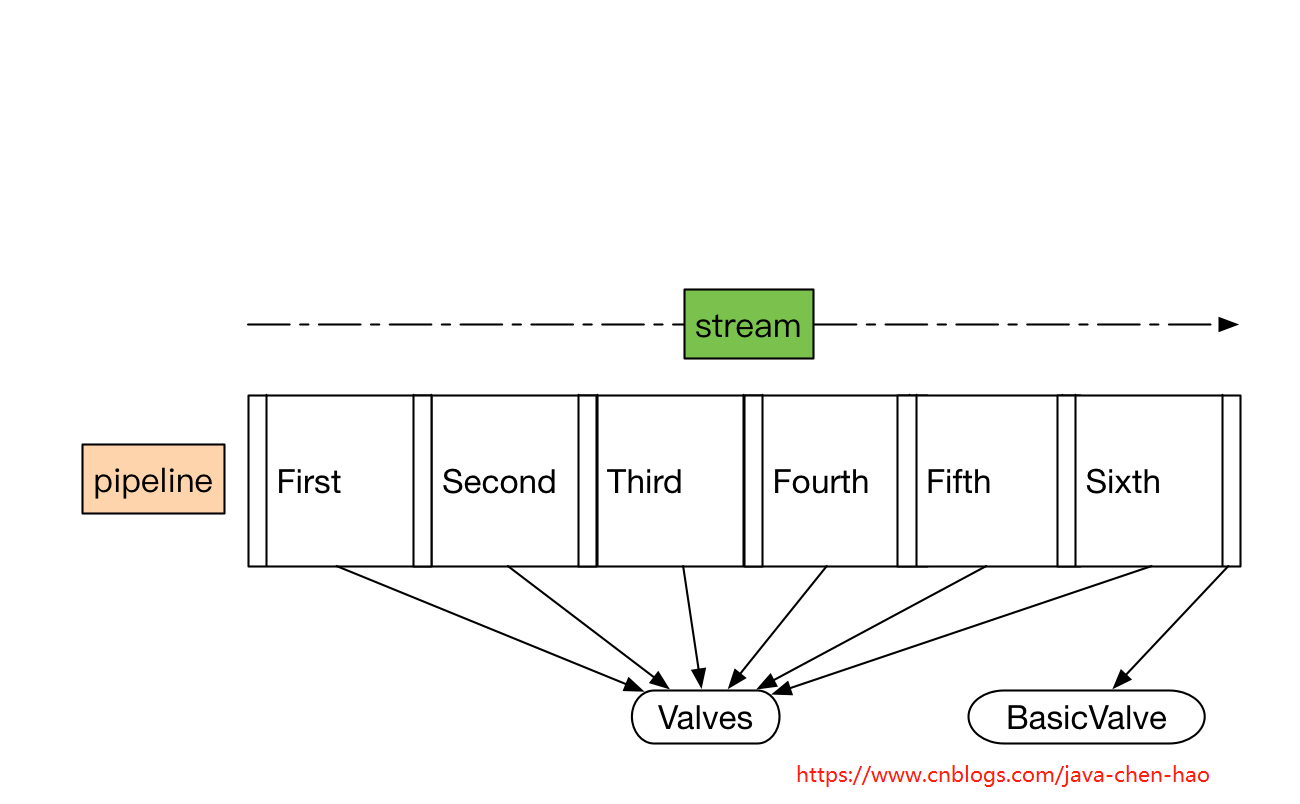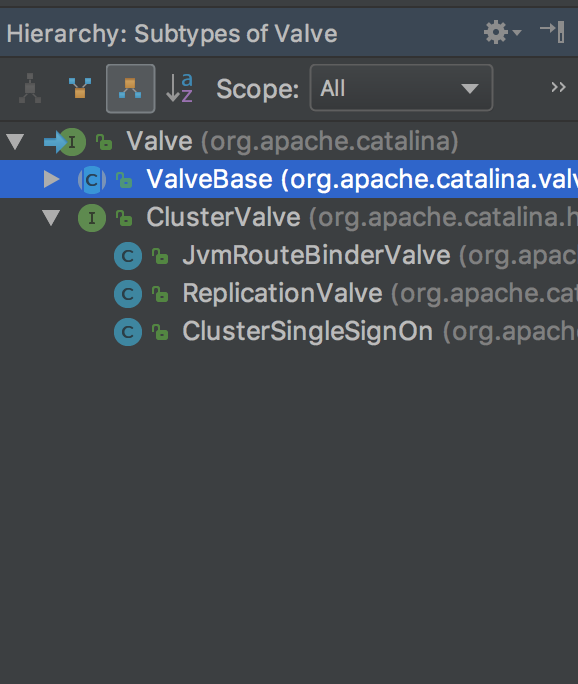Tomcat源码分析 (四)----- Pipeline和Valve
在 Tomcat源码分析 (二)----- Tomcat整体架构及组件 中我们简单分析了一下Pipeline和Valve,并给出了整体的结构图。而这一节,我们将详细分析Tomcat里面的源码。

Valve
Valve作为一个个基础的阀门,扮演着业务实际执行者的角色。我们看看Valve这个接口有哪些方法。
public interface Valve {
// 获取下一个阀门
public Valve getNext();
// 设置下一个阀门
public void setNext(Valve valve);
// 后台执行逻辑,主要在类加载上下文中使用到
public void backgroundProcess();
// 执行业务逻辑
public void invoke(Request request, Response response)
throws IOException, ServletException;
// 是否异步执行
public boolean isAsyncSupported();
}
Contained
ValveBase、Pipeline及其他相关组件都实现了Contained接口,我们看看这个接口有哪些方法。很简单,就是get/set容器操作。
public interface Contained {
/**
* Get the {@link Container} with which this instance is associated.
*
* @return The Container with which this instance is associated or
* <code>null</code> if not associated with a Container
*/
Container getContainer();
/**
* Set the <code>Container</code> with which this instance is associated.
*
* @param container The Container instance with which this instance is to
* be associated, or <code>null</code> to disassociate this instance
* from any Container
*/
void setContainer(Container container);
}
ValveBase
从Valve的类层次结构,我们发现几乎所有Valve都继承了ValveBase这个抽象类,所以这儿我们需要分析一下它。

public abstract class ValveBase extends LifecycleMBeanBase implements Contained, Valve {
// 国际化管理器,可以支持多国语言
protected static final StringManager sm = StringManager.getManager(ValveBase.class);
//------------------------------------------------------ Instance Variables
// 无参构造方法,默认不支持异步
public ValveBase() {
this(false);
}
// 有参构造方法,可传入异步支持标记
public ValveBase(boolean asyncSupported) {
this.asyncSupported = asyncSupported;
}
//------------------------------------------------------ Instance Variables
// 异步标记
protected boolean asyncSupported;
// 所属容器
protected Container container = null;
// 容器日志组件对象
protected Log containerLog = null;
// 下一个阀门
protected Valve next = null;
//-------------------------------------------------------------- Properties
// 获取所属容器
@Override
public Container getContainer() {
return container;
}
// 设置所属容器
@Override
public void setContainer(Container container) {
this.container = container;
}
// 是否异步执行
@Override
public boolean isAsyncSupported() {
return asyncSupported;
}
// 设置是否异步执行
public void setAsyncSupported(boolean asyncSupported) {
this.asyncSupported = asyncSupported;
}
// 获取下一个待执行的阀门
@Override
public Valve getNext() {
return next;
}
// 设置下一个待执行的阀门
@Override
public void setNext(Valve valve) {
this.next = valve;
}
//---------------------------------------------------------- Public Methods
// 后台执行,子类实现
@Override
public void backgroundProcess() {
// NOOP by default
}
// 初始化逻辑
@Override
protected void initInternal() throws LifecycleException {
super.initInternal();
// 设置容器日志组件对象到当前阀门的containerLog属性
containerLog = getContainer().getLogger();
}
// 启动逻辑
@Override
protected synchronized void startInternal() throws LifecycleException {
setState(LifecycleState.STARTING);
}
// 停止逻辑
@Override
protected synchronized void stopInternal() throws LifecycleException {
setState(LifecycleState.STOPPING);
}
// 重写toString,格式为[${containerName}]
@Override
public String toString() {
StringBuilder sb = new StringBuilder(this.getClass().getName());
sb.append('[');
if (container == null) {
sb.append("Container is null");
} else {
sb.append(container.getName());
}
sb.append(']');
return sb.toString();
}
// -------------------- JMX and Registration --------------------
// 设置获取MBean对象的keyProperties,格式如:a=b,c=d,e=f...
@Override
public String getObjectNameKeyProperties() {
StringBuilder name = new StringBuilder("type=Valve");
Container container = getContainer();
name.append(container.getMBeanKeyProperties());
int seq = ;
// Pipeline may not be present in unit testing
Pipeline p = container.getPipeline();
if (p != null) {
for (Valve valve : p.getValves()) {
// Skip null valves
if (valve == null) {
continue;
}
// Only compare valves in pipeline until we find this valve
if (valve == this) {
break;
}
if (valve.getClass() == this.getClass()) {
// Duplicate valve earlier in pipeline
// increment sequence number
seq ++;
}
}
}
if (seq > ) {
name.append(",seq=");
name.append(seq);
}
String className = this.getClass().getName();
int period = className.lastIndexOf('.');
if (period >= ) {
className = className.substring(period + );
}
name.append(",name=");
name.append(className);
return name.toString();
}
// 获取所属域,从container获取
@Override
public String getDomainInternal() {
Container c = getContainer();
if (c == null) {
return null;
} else {
return c.getDomain();
}
}
}
Pipeline
Pipeline作为一个管道,我们可以简单认为是一个Valve的集合,内部会对这个集合进行遍历,调用每个元素的业务逻辑方法invoke()。
是不是这样呢?我们还是分析一下源码,先看看接口定义。
public interface Pipeline {
// ------------------------------------------------------------- Properties
// 获取基本阀门
public Valve getBasic();
// 设置基本阀门
public void setBasic(Valve valve);
// --------------------------------------------------------- Public Methods
// 添加阀门
public void addValve(Valve valve);
// 获取阀门数组
public Valve[] getValves();
// 删除阀门
public void removeValve(Valve valve);
// 获取首个阀门
public Valve getFirst();
// 管道内所有阀门是否异步执行
public boolean isAsyncSupported();
// 获取管道所属的容器
public Container getContainer();
// 设置管道所属的容器
public void setContainer(Container container);
// 查找非异步执行的所有阀门,并放置到result参数中,所以result不允许为null
public void findNonAsyncValves(Set<String> result);
}
StandardPipeline
接着我们分析一下Pipeline唯一的实现StandardPipeline。代码很长,但是都很简单。
public class StandardPipeline extends LifecycleBase
implements Pipeline, Contained { private static final Log log = LogFactory.getLog(StandardPipeline.class); // ----------------------------------------------------------- Constructors // 构造一个没有所属容器的管道
public StandardPipeline() {
this(null);
} // 构造一个有所属容器的管道
public StandardPipeline(Container container) {
super();
setContainer(container);
} // ----------------------------------------------------- Instance Variables /**
* 基本阀门,最后执行的阀门
*/
protected Valve basic = null; /**
* 管道所属的容器
*/
protected Container container = null; /**
* 管道里面的首个执行的阀门
*/
protected Valve first = null; // --------------------------------------------------------- Public Methods // 是否异步执行,如果一个阀门都没有,或者所有阀门都是异步执行的,才返回true
@Override
public boolean isAsyncSupported() {
Valve valve = (first!=null)?first:basic;
boolean supported = true;
while (supported && valve!=null) {
supported = supported & valve.isAsyncSupported();
valve = valve.getNext();
}
return supported;
} // 查找所有未异步执行的阀门
@Override
public void findNonAsyncValves(Set<String> result) {
Valve valve = (first!=null) ? first : basic;
while (valve != null) {
if (!valve.isAsyncSupported()) {
result.add(valve.getClass().getName());
}
valve = valve.getNext();
}
} // ------------------------------------------------------ Contained Methods // 获取所属容器
@Override
public Container getContainer() {
return (this.container);
} // 设置所属容器
@Override
public void setContainer(Container container) {
this.container = container;
} // 初始化逻辑,默认没有任何逻辑
@Override
protected void initInternal() {
// NOOP
} // 开始逻辑,调用所有阀门的start方法
@Override
protected synchronized void startInternal() throws LifecycleException {
// Start the Valves in our pipeline (including the basic), if any
Valve current = first;
if (current == null) {
current = basic;
}
while (current != null) {
if (current instanceof Lifecycle)
((Lifecycle) current).start();
current = current.getNext();
} setState(LifecycleState.STARTING);
} // 停止逻辑,调用所有阀门的stop方法
@Override
protected synchronized void stopInternal() throws LifecycleException {
setState(LifecycleState.STOPPING); // Stop the Valves in our pipeline (including the basic), if any
Valve current = first;
if (current == null) {
current = basic;
}
while (current != null) {
if (current instanceof Lifecycle)
((Lifecycle) current).stop();
current = current.getNext();
}
} // 销毁逻辑,移掉所有阀门,调用removeValve方法
@Override
protected void destroyInternal() {
Valve[] valves = getValves();
for (Valve valve : valves) {
removeValve(valve);
}
} /**
* 重新toString方法
*/
@Override
public String toString() {
StringBuilder sb = new StringBuilder("Pipeline[");
sb.append(container);
sb.append(']');
return sb.toString();
} // ------------------------------------------------------- Pipeline Methods // 获取基础阀门
@Override
public Valve getBasic() {
return (this.basic);
} // 设置基础阀门
@Override
public void setBasic(Valve valve) {
// Change components if necessary
Valve oldBasic = this.basic;
if (oldBasic == valve)
return; // Stop the old component if necessary
// 老的基础阀门会被调用stop方法且所属容器置为null
if (oldBasic != null) {
if (getState().isAvailable() && (oldBasic instanceof Lifecycle)) {
try {
((Lifecycle) oldBasic).stop();
} catch (LifecycleException e) {
log.error("StandardPipeline.setBasic: stop", e);
}
}
if (oldBasic instanceof Contained) {
try {
((Contained) oldBasic).setContainer(null);
} catch (Throwable t) {
ExceptionUtils.handleThrowable(t);
}
}
} // Start the new component if necessary
// 新的阀门会设置所属容器,并调用start方法
if (valve == null)
return;
if (valve instanceof Contained) {
((Contained) valve).setContainer(this.container);
}
if (getState().isAvailable() && valve instanceof Lifecycle) {
try {
((Lifecycle) valve).start();
} catch (LifecycleException e) {
log.error("StandardPipeline.setBasic: start", e);
return;
}
} // Update the pipeline
// 替换pipeline中的基础阀门,就是讲基础阀门的前一个阀门的next指向当前阀门
Valve current = first;
while (current != null) {
if (current.getNext() == oldBasic) {
current.setNext(valve);
break;
}
current = current.getNext();
} this.basic = valve;
} // 添加阀门
@Override
public void addValve(Valve valve) {
// Validate that we can add this Valve
// 设置所属容器
if (valve instanceof Contained)
((Contained) valve).setContainer(this.container); // Start the new component if necessary
// 调用阀门的start方法
if (getState().isAvailable()) {
if (valve instanceof Lifecycle) {
try {
((Lifecycle) valve).start();
} catch (LifecycleException e) {
log.error("StandardPipeline.addValve: start: ", e);
}
}
} // Add this Valve to the set associated with this Pipeline
// 设置阀门,将阀门添加到基础阀门的前一个
if (first == null) {
first = valve;
valve.setNext(basic);
} else {
Valve current = first;
while (current != null) {
if (current.getNext() == basic) {
current.setNext(valve);
valve.setNext(basic);
break;
}
current = current.getNext();
}
} container.fireContainerEvent(Container.ADD_VALVE_EVENT, valve);
} // 获取阀门数组
@Override
public Valve[] getValves() {
ArrayList<Valve> valveList = new ArrayList<>();
Valve current = first;
if (current == null) {
current = basic;
}
while (current != null) {
valveList.add(current);
current = current.getNext();
} return valveList.toArray(new Valve[0]);
} // JMX方法,在此忽略
public ObjectName[] getValveObjectNames() {
ArrayList<ObjectName> valveList = new ArrayList<>();
Valve current = first;
if (current == null) {
current = basic;
}
while (current != null) {
if (current instanceof JmxEnabled) {
valveList.add(((JmxEnabled) current).getObjectName());
}
current = current.getNext();
} return valveList.toArray(new ObjectName[0]);
} // 移除阀门
@Override
public void removeValve(Valve valve) {
Valve current;
if(first == valve) {
// 如果待移出的阀门是首个阀门,则首个阀门的下一个阀门变成首个阀门
first = first.getNext();
current = null;
} else {
current = first;
}
// 遍历阀门集合,并进行移除
while (current != null) {
if (current.getNext() == valve) {
current.setNext(valve.getNext());
break;
}
current = current.getNext();
} if (first == basic) first = null; // 设置阀门所属容器为null
if (valve instanceof Contained)
((Contained) valve).setContainer(null); // 调用待移除阀门的stop方法和destroy方法,并触发移除阀门事件
if (valve instanceof Lifecycle) {
// Stop this valve if necessary
if (getState().isAvailable()) {
try {
((Lifecycle) valve).stop();
} catch (LifecycleException e) {
log.error("StandardPipeline.removeValve: stop: ", e);
}
}
try {
((Lifecycle) valve).destroy();
} catch (LifecycleException e) {
log.error("StandardPipeline.removeValve: destroy: ", e);
}
} container.fireContainerEvent(Container.REMOVE_VALVE_EVENT, valve);
} // 获取首个阀门,如果阀门列表为null,返回基础阀门
@Override
public Valve getFirst() {
if (first != null) {
return first;
}
return basic;
}
}
总结
通过上面的代码分析,我们发现了几个关键的设计模式:
- 模板方法模式,父类定义框架,子类实现
- 责任链模式,就是这儿的管道/阀门的实现方式,每个阀门维护一个next属性指向下一个阀门
Tomcat源码分析 (四)----- Pipeline和Valve的更多相关文章
- Tomcat 源码分析(转)
本文转自:http://blog.csdn.net/haitao111313/article/category/1179996 Tomcat源码分析(一)--服务启动 1. Tomcat主要有两个组件 ...
- Tomcat源码分析之—具体启动流程分析
从Tomcat启动调用栈可知,Bootstrap类的main方法为整个Tomcat的入口,在init初始化Bootstrap类的时候为设置Catalina的工作路径也就是Catalina_HOME信息 ...
- Tomcat源码分析--转
一.架构 下面谈谈我对Tomcat架构的理解 总体架构: 1.面向组件架构 2.基于JMX 3.事件侦听 1)面向组件架构 tomcat代码看似很庞大,但从结构上看却很清晰和简单,它主要由一堆组件组成 ...
- Tomcat源码分析
前言: 本文是我阅读了TOMCAT源码后的一些心得. 主要是讲解TOMCAT的系统框架, 以及启动流程.若有错漏之处,敬请批评指教! 建议: 毕竟TOMCAT的框架还是比较复杂的, 单是从文字上理解, ...
- Tomcat源码分析——请求原理分析(下)
前言 本文继续讲解TOMCAT的请求原理分析,建议朋友们阅读本文时首先阅读过<TOMCAT源码分析——请求原理分析(上)>和<TOMCAT源码分析——请求原理分析(中)>.在& ...
- Tomcat源码分析——请求原理分析(中)
前言 在<TOMCAT源码分析——请求原理分析(上)>一文中已经介绍了关于Tomcat7.0处理请求前作的初始化和准备工作,请读者在阅读本文前确保掌握<TOMCAT源码分析——请求原 ...
- Tomcat源码分析——请求原理分析(上)
前言 谈起Tomcat的诞生,最早可以追溯到1995年.近20年来,Tomcat始终是使用最广泛的Web服务器,由于其使用Java语言开发,所以广为Java程序员所熟悉.很多人早期的J2EE项目,由程 ...
- Tomcat源码分析(二)------ 一次完整请求的里里外外
Tomcat源码分析(二)------ 一次完整请求的里里外外 前几天分析了一下Tomcat的架构和启动过程,今天开始研究它的运转机制.Tomcat最本质就是个能运行JSP/Servlet的Web ...
- tomcat源码--springboot整合tomcat源码分析
1.测试代码,一个简单的springboot web项目:地址:https://gitee.com/yangxioahui/demo_mybatis.git 一:tomcat的主要架构:1.如果我们下 ...
随机推荐
- 如何实现LRU算法?
1.什么是LRU算法? LRU是一种缓存淘汰机制策略. 计算机的缓存容量有限,如果缓存满了就要删除一些内容,给新的内容腾位置.但是要删除哪些内容呢?我们肯定希望删掉那些没有用的缓存,而把有用的数据继续 ...
- Altium Designer设计PCB--如何设置铺铜与导线或过孔的间距
笑话: 到银行汇款,车临时停路边上. 为了怕交警罚就把朋友留下看车,跟他说有查车的过来了告诉我一声. 进去几分钟果然有交警来了. 那个朋友风风火火地闯进银行大声吼道:“大哥,警察来了,快走啊!” 偌大 ...
- Spark 的 python 编程环境
Spark 可以独立安装使用,也可以和 Hadoop 一起安装使用.在安装 Spark 之前,首先确保你的电脑上已经安装了 Java 8 或者更高的版本. Spark 安装 访问Spark 下载页面, ...
- 小代学Spring Boot之集成MyBatis
想要获取更多文章可以访问我的博客 - 代码无止境. 上一篇小代同学在Spring Boot项目中配置了数据源,但是通常来讲我们访问数据库都会通过一个ORM框架,很少会直接使用JDBC来执行数据库操作的 ...
- UVA1152- 枚举 /二分查找
The SUM problem can be formulated as follows: given four lists A,B,C,D of integer values, compute ho ...
- java ServletContextListener 实现UDP监听
使用spring boot实现项目启动时的监听, UDPListener import java.io.IOException;import java.io.UnsupportedEncodingEx ...
- Git对象
上一节了解了 Git 的一个重要的概念:暂存区. 暂存区是一个介于工作区和版本库的中间状态,当执行commit时,实际上是将暂存区的内容提交大版本库中,而执行add则是将本次变更添加到暂存区. 上一节 ...
- 2019年7月20日 - LeetCode0002
https://leetcode-cn.com/problems/add-two-numbers/submissions/ 我的方法: /** * Definition for singly-link ...
- Spring:定时任务定时器 Quartz的使用
Quartz的使用方式 配置文件方式 一.引入依赖 <!-- spring 其他依赖省略 --> <!-- https://mvnrepository.com/artifact/or ...
- nl2br()处理字符串中的换行符
nl2br() 函数 在字符串中包含换行符时,需要对其进行转换,php 中有str_replace()函数,可以直接对字符串进行替换处理.但php中还有nl2br()函数可以直接处理. 1.在字符串中 ...
